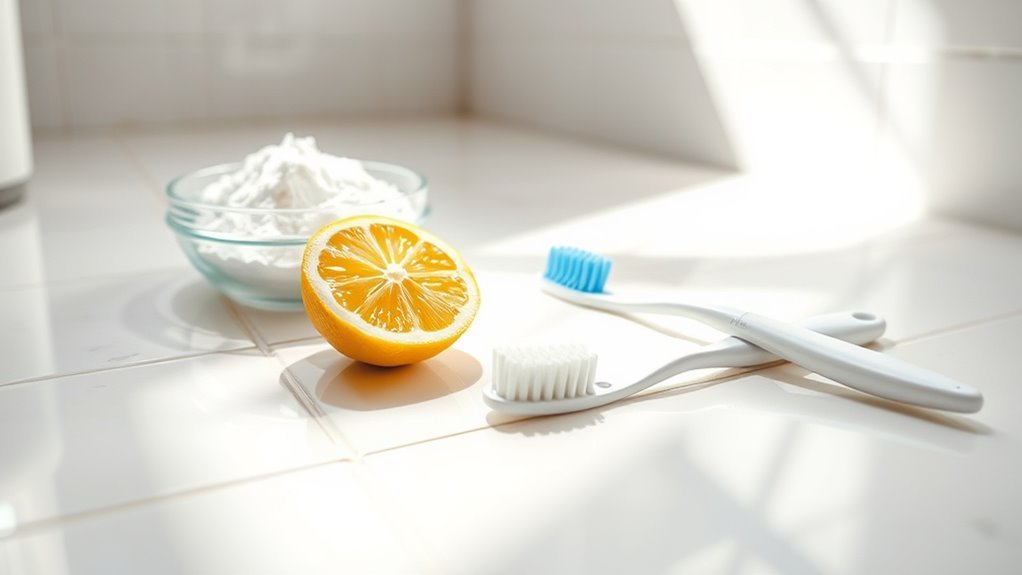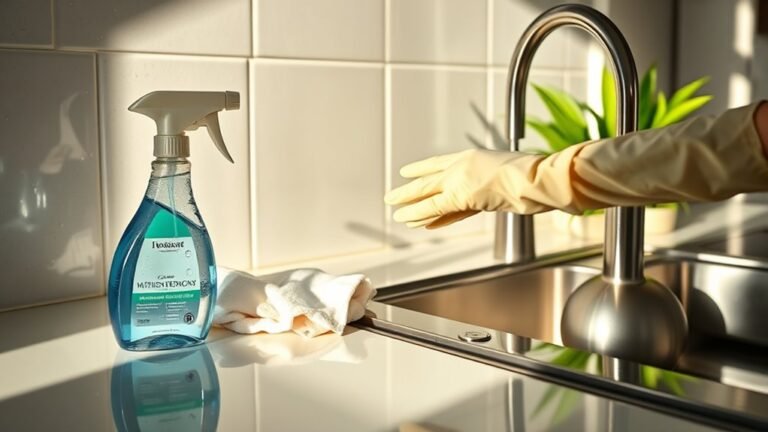Natural Cleaning Hacks for Your Grout
You can naturally brighten grout with simple hacks like baking soda and vinegar paste, which fizzes away grime, or a hydrogen peroxide and baking soda mix for tougher stains. Lemon juice combined with baking soda works as a gentle scrub, while steam cleaning loosens dirt without chemicals. Toothpaste is a quick fix for minor spots, and oxygen bleach offers deep cleaning without harsh toxins. Adding essential oils keeps your grout fresh and mildew-free. There’s a lot more you can do to keep grout looking great and fresh.
Baking Soda and Vinegar Paste
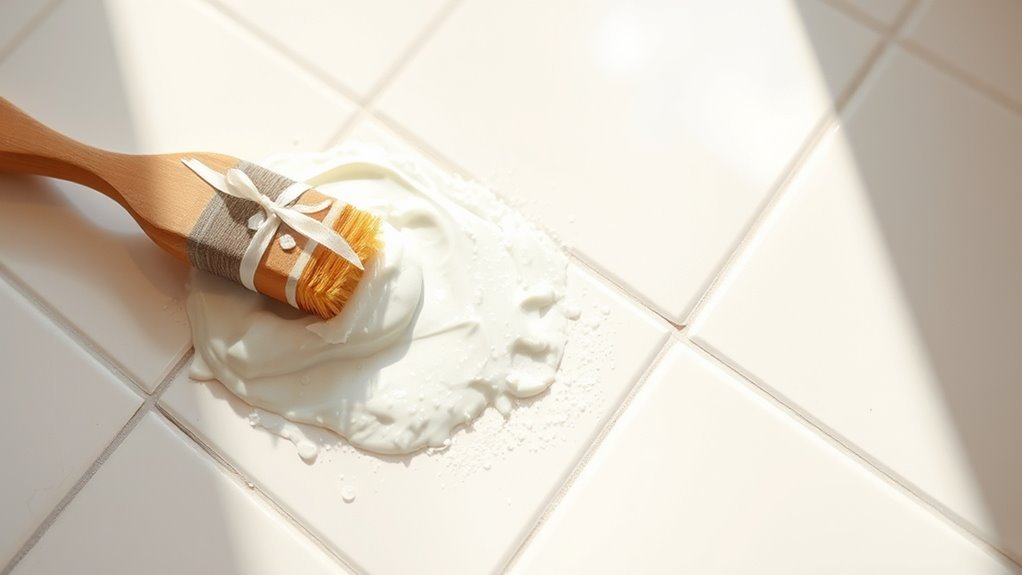
Though it might sound simple, using a baking soda and vinegar paste is one of the most effective natural methods to clean grout. You don’t need harsh chemicals when this dynamic duo works wonders. Start by mixing baking soda with water to form a thick paste. Then, spray or pour vinegar over the grout, letting the fizzing action break down dirt and grime. The ideal vinegar ratios guarantee you get enough acidity to lift stains without damaging your surfaces. Apply the paste and vinegar combo, scrub with a brush, and rinse away. This method gives you freedom from toxic cleaners while restoring your grout’s brightness. Embracing baking soda and vinegar ratios means you’re choosing a simple, powerful, and natural grout cleaning routine you can trust.
Hydrogen Peroxide and Baking Soda Solution
Two common household ingredients—hydrogen peroxide and baking soda—combine to create a powerful natural solution for cleaning grout. This duo maximizes hydrogen uses, delivering impressive cleaning benefits without harsh chemicals. Here’s how you can use it:
- Mix 1/2 cup baking soda with 1/4 cup hydrogen peroxide to form a paste.
- Apply the paste to grout lines and let it sit for 10 minutes to break down stains.
- Scrub gently with a brush, then rinse with warm water for sparkling results.
This combo gives you freedom from stubborn grime, letting you refresh grout naturally and effectively. It’s perfect if you want an eco-friendly, safe option that works hard without sacrificing your space’s integrity.
Lemon Juice and Baking Soda Scrub
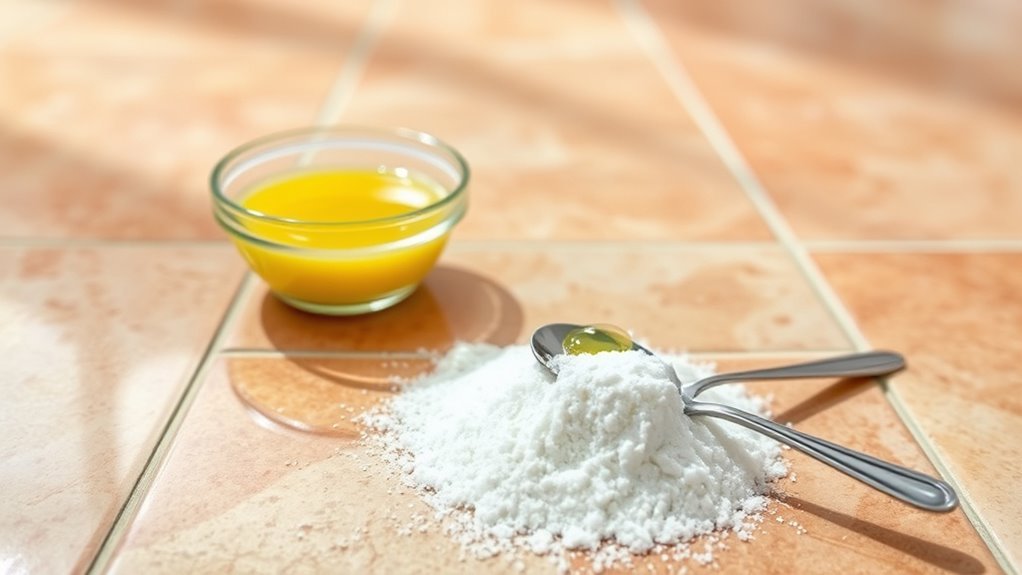
You can tackle tough grout stains by mixing lemon juice with baking soda for a powerful scrub. This combo not only lifts stains effectively but also naturally disinfects the area. It’s a simple, eco-friendly way to keep your grout looking fresh and clean.
Effective Stain Removal
When grout stains start to show, a simple lemon juice and baking soda scrub can work wonders. You don’t have to rely on harsh chemicals; this natural alternative is both effective and freeing. Here’s how to tackle those stubborn marks:
- Mix lemon juice with baking soda into a paste.
- Apply it to the stained grout and let it sit for 5-10 minutes.
- Scrub gently with a brush, then rinse with warm water.
This method lifts stains without damaging your grout or compromising grout sealing efforts. Using natural alternatives like this keeps your space fresh and safe, giving you the freedom to maintain your home without worry. Try it, and enjoy cleaner grout with less hassle!
Natural Disinfectant Properties
Lemon juice and baking soda aren’t just great for scrubbing grout—they also offer natural disinfectant properties that help keep your surfaces hygienic. When you mix these two, you create a powerful, eco-friendly cleaner that tackles germs without harsh chemicals. Lemon’s acidity breaks down bacteria, while baking soda’s gentle abrasiveness lifts dirt and neutralizes odors. Using these natural disinfectants for grout cleaning means you’re choosing a safer way to maintain your home’s cleanliness and your freedom from toxic substances. Just apply the paste, scrub gently with a brush, and rinse with warm water. You’ll see your grout brighten up while feeling confident that you’ve cleaned with ingredients straight from nature, preserving both your health and your space.
Steam Cleaning for Grout
Although steam cleaning might seem like a high-tech solution, it’s actually a simple and effective way to refresh your grout without harsh chemicals. You’ll love the steam cleaning benefits: it loosens dirt, kills bacteria, and brightens grout lines naturally. To get started, follow these steam cleaning techniques:
- Fill your steam cleaner with water and let it heat up fully for maximum effectiveness.
- Slowly move the steam nozzle over your grout, allowing the steam to penetrate and loosen grime.
- Wipe away loosened dirt with a microfiber cloth or brush for a spotless finish.
This method gives you freedom from toxic cleaners while restoring your grout’s original look, making your space cleaner and healthier.
Toothpaste as a Grout Cleaner
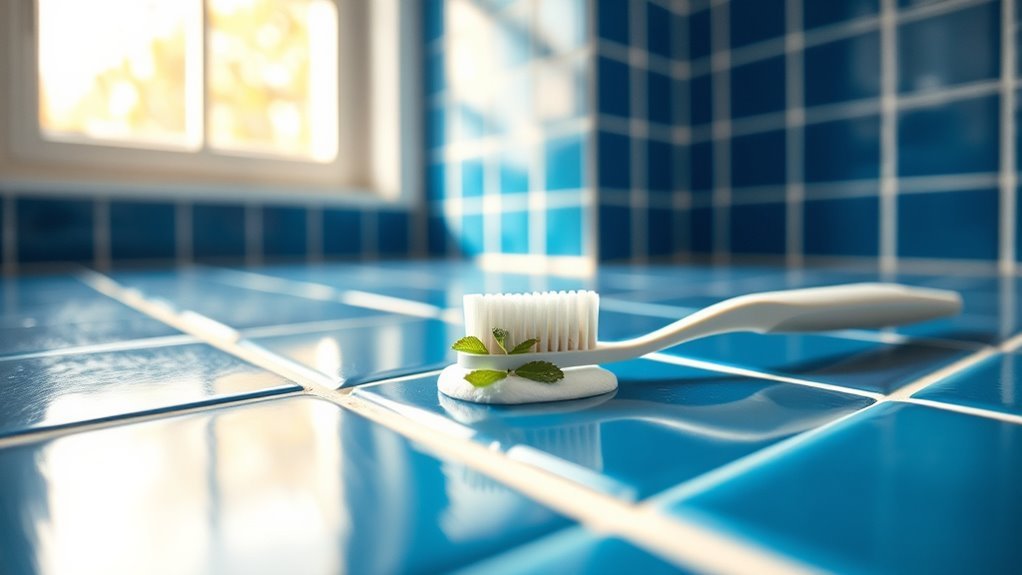
You can use white, non-gel toothpaste to clean grout effectively without harsh chemicals. Just apply a small amount, scrub gently with a toothbrush, and rinse for a fresh, bright result. Toothpaste is great because it’s affordable, easy to find, and safe for most grout types.
Toothpaste Types to Use
Several types of toothpaste can effectively clean grout, but choosing the right one makes a difference. You want a product that’s tough on stains yet gentle on your grout. Here are three types to take into account:
- Whitening toothpaste – Packed with mild abrasives, it lifts stains without harsh chemicals, making your grout shine naturally.
- Gel toothpaste – Its smooth texture spreads easily and penetrates grout lines for even cleaning action.
- Baking soda toothpaste – Often containing baking soda, it combines mild abrasiveness with natural deodorizing power to refresh grout.
Avoid toothpastes with strong dyes or gels with added colors, as these can stain grout. Stick to simple, natural formulas to keep your cleaning routine free and effective. Choose the toothpaste that fits your style and enjoy spotless grout without sacrificing your freedom to use natural products.
Application Techniques
When applying toothpaste as a grout cleaner, using the right technique can make all the difference in achieving a spotless finish. You want to focus on grout application that maximizes toothpaste’s cleaning power without damaging your tiles. Start by squeezing a small amount of toothpaste directly onto the grout lines, then use an old toothbrush to scrub gently in circular motions. These cleaning techniques help lift dirt efficiently. After scrubbing, wipe away residue with a damp cloth and let the grout dry.
| Step | Description |
|---|---|
| 1. Apply | Squeeze toothpaste on grout lines |
| 2. Scrub | Use toothbrush, circular motions |
| 3. Wait | Let toothpaste sit for 5-10 minutes |
| 4. Wipe | Remove toothpaste with damp cloth |
| 5. Dry | Allow grout to air dry completely |
Mastering these steps sets you free from harsh chemicals!
Benefits of Toothpaste Cleaning
Following the right application techniques guarantees you get the most out of toothpaste as a grout cleaner. Toothpaste ingredients like mild abrasives and baking soda make it a powerful yet gentle option for grout whitening. Plus, it’s readily available and affordable, giving you freedom from harsh chemicals.
Here’s why toothpaste works so well:
- Effective Whitening: The mild abrasives scrub away stains without damaging grout.
- Easy to Use: Apply directly with a toothbrush, no extra mixing needed.
- Safe & Eco-Friendly: Free from harsh chemicals, protecting your home and the environment.
Using toothpaste for grout cleaning lets you refresh your tiles naturally, saving money while enjoying a brighter, cleaner space with less effort.
Oxygen Bleach for Deep Cleaning
One powerful trick you can use for deep cleaning grout is oxygen bleach, a gentle yet effective alternative to harsh chemicals. Oxygen bleach advantages include its ability to lift stains and brighten grout without damaging tiles or releasing harmful fumes. It works by releasing oxygen that breaks down dirt and mold, making your grout look fresh and clean. Unlike chlorine bleach, oxygen bleach is safer for your health and the environment, giving you the freedom to clean confidently. If you’re looking for oxygen bleach alternatives, substances like baking soda combined with hydrogen peroxide can offer similar results but may require more scrubbing. Embracing oxygen bleach lets you maintain grout naturally, freeing yourself from harsh chemicals while achieving a deep, thorough clean every time.
Essential Oils for Grout Maintenance
Although oxygen bleach is great for deep cleaning, essential oils can be your go-to for regular grout maintenance. They naturally invigorate and protect without harsh chemicals, giving you freedom from toxic cleaners. Here’s how to use essential oil blends effectively:
- Mix a few drops of tea tree and eucalyptus oils with water in a spray bottle. Spray onto grout and wipe clean to prevent mildew.
- For grout deodorizing tips, combine lemon and lavender oils with baking soda into a paste. Apply, let sit 10 minutes, then scrub gently.
- Add peppermint oil to your mop water for a revitalizing clean that also repels dirt buildup.
Using essential oils keeps your grout fresh and cared for, so you can enjoy a naturally bright, inviting space with minimal effort.
Frequently Asked Questions
Can Natural Cleaners Damage Grout Over Time?
You might say natural cleaners are gentle companions, but even the kindest can quietly test grout longevity if used too often. When you embrace cleaning frequency wisely, you give your grout the freedom to stay strong and vibrant. Overdoing it, even with natural solutions, can wear down grout slowly. So, balance is your best friend—clean often enough to refresh, but not so much that you risk sacrificing that lasting durability you want.
How Often Should Grout Be Sealed After Cleaning?
You should aim for grout sealing frequency of once every 1 to 3 years, depending on the grout type and usage. Regular grout maintenance tips include cleaning grout lines thoroughly before sealing and avoiding harsh chemicals. Keeping up with this schedule helps protect your grout from stains and moisture, giving you more freedom from constant upkeep. Seal it when the grout starts to look dull or absorbs water to keep it strong and fresh.
Are Natural Cleaning Methods Safe for Colored Grout?
Imagine your colored grout turning into a rainbow mess after one wrong scrub—sounds like a nightmare, right? Don’t worry, when it comes to colored grout safety, natural cleaners are usually gentle and effective, so they won’t strip or fade those vibrant hues. You get the freedom to clean without harsh chemicals messing things up. Just test a small spot first to ascertain your natural cleaner effectiveness matches your grout’s color resilience perfectly.
Can Natural Cleaners Remove Mold From Grout?
You might wonder if natural cleaners can handle mold removal on grout effectively. The good news? They often can, especially with ingredients like vinegar and baking soda, which offer solid cleaning effectiveness without harsh chemicals. While they might take a bit more elbow grease than commercial products, natural solutions let you tackle mold safely and freely, avoiding toxic residues. Just remember to scrub well and rinse thoroughly for best results.
What Tools Are Best for Applying Natural Grout Cleaners?
When it comes to applying natural grout cleaners, you’ve got to let your tools do the heavy lifting. Start with spray bottles to evenly mist your solution, giving you control and freedom to target those stubborn spots. Then, grab scrubbing brushes with stiff bristles—they’re like your trusty sidekick, scrubbing away grime and mold without wearing you down. Together, these tools make your cleaning routine smooth and effective, freeing you from endless elbow grease.
